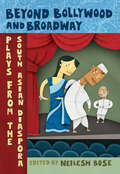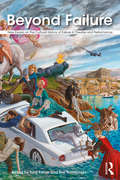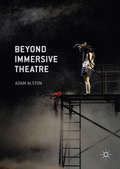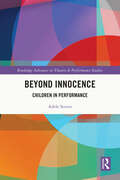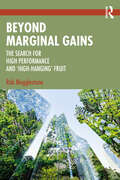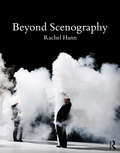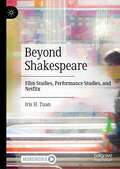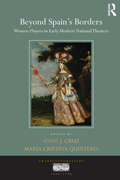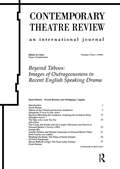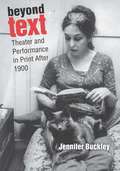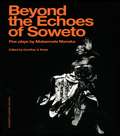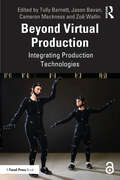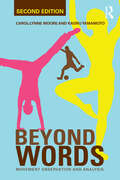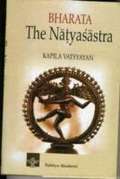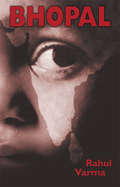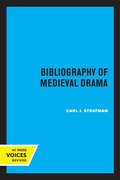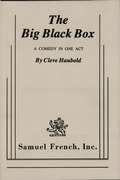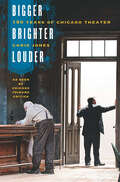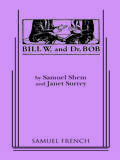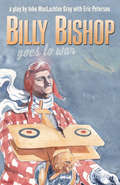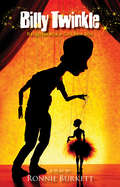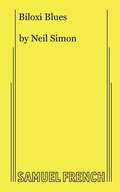- Table View
- List View
Beyond Bollywood and Broadway: Plays from the South Asian Diaspora
by Neilesh BoseThis collection of 11 plays, from North America, the U.K., and South Africa—many published here for the first time—delves into the vibrant, cosmopolitan theatre of the South Asian diaspora. These original and provocative works explore the experience of diaspora by drawing on cultural references as diverse as classical Indian texts, adaptations of Shakespeare and Homer, current events, and world music, film, and dance. Neilesh Bose provides historical background on South Asian migration and performance traditions in each region, along with critical introductions and biographical background on each playwright.Includes works by Anuvab Pal, Aasif Mandvi, Shishir Kurup, Rahul Varma, Rana Bose, Rukhsana Ahmad, Jatinder Verma, Sudha Bhuchar and Kristine Landon-Smith, Ronnie Govender, Kessie Govender, and Kriben Pillay.
Beyond Failure: New Essays on the Cultural History of Failure in Theatre and Performance
by Tony Fisher Eve KatsourakiIn setting foot on stage, every performer risks the possiblity of failure. Indeed, the very performance of any human action is inextricable from its potential not to succeed. This inherent potential has become a key critical trope in contemporary theatre, performance studies, and scholarship around visual cultures. Beyond Failure explores what it means for our understanding not just of theatrical practice but of human social and cultural activity more broadly. The essays in this volume tackle contemporary debates around the theory and poetics of failure, suggesting that in the absence of success can be found a defiance and hopefulness that points to new ways of knowing and being in the world. Beyond Failure offers a unique and engaging approach for students and practitioners interested not only in the impact of failure on the stage, but what it means for wider social and cultural debates.
Beyond Immersive Theatre: Aesthetics, Politics and Productive Participation
by Adam AlstonImmersive theatre currently enjoys ubiquity, popularity and recognition in theatre journalism and scholarship. However, the politics of immersive theatre aesthetics still lacks a substantial critique. Does immersive theatre model a particular kind of politics, or a particular kind of audience? What's involved in the production and consumption of immersive theatre aesthetics? Is a productive audience always an empowered audience? And do the terms of an audience's empowerment stand up to political scrutiny? Beyond Immersive Theatre contextualises these questions by tracing the evolution of neoliberal politics and the experience economy over the past four decades. Through detailed critical analyses of work by Ray Lee, Lundahl & Seitl, Punchdrunk, shunt, Theatre Delicatessen and Half Cut, Adam Alston argues that there is a tacit politics to immersive theatre aesthetics - a tacit politics that is illuminated by neoliberalism, and that is ripe to be challenged by the evolution and diversification of immersive theatre.
Beyond Innocence: Children in Performance (ISSN)
by Adele SeniorOn a global platform we are witnessing the increased visibility of the people we call children and teenagers as political activists.Meanwhile, across the contemporary performance landscape, children are participating as performers and collaborators in ways that resonate with this figure of the child activist. Beyond Innocence: Children in Performance proposes that performance has the ability to offer alternatives to hegemonic perceptions of the child as innocent, in need of protection, and apolitical. Through an in-depth analysis of selected performances shown in the UK within the past decade, alongside newly gathered documentation on children’s participation in professional performance in their own words, this book considers how performance might offer more capacious representations of and encounters with children beyond the nostalgic and protective adult gaze elicited within mainstream contexts. Motivated by recent collaborations with children on stage that reimagine the figure of the child, the book offers a new approach to both reading age in performance and also doing research with children rather than on or about them. By redressing the current imbalance between the way that we read children and adults’ bodies in performance and taking seriously children’s cultures and experiences, Beyond Innocence asks what strategies contemporary performance has to offer both children and adults in order to foster shared spaces for social and political change. As such, the book develops an approach to analysing performance that not only recognises children as makers of meaning but also as historically, politically, and culturally situated subjects and bodies with lived experiences that far exceed the familiar narratives of innocence and inexperience that children often have to bear.
Beyond Marginal Gains: The Search for High Performance and ‘High-Hanging’ Fruit
by Rob MugglestoneShowcasing the Optimal, Maximal, Incremental, and Threshold (OMIT) and Accelerate The Curve (ATC) models, this book offers a solid understanding of high performance and how to improve it.The concept of marginal gains is well known – make small improvements and increase performance. What happens when these gains are harder to find? This book answers all your performance-related questions including: How can I continue to improve, even if I am better than I have ever been, and better than everyone else? How can I use my time, energy and resources better, so that I can improve more, with less? The book begins by introducing two concepts for high performance – OMIT and ATC. Using high-profile case studies, it maps the performance of business and sporting organisations, as well as individuals, against these models and offers practical advice for those looking to understand and improve their own performance using these concepts. Beyond marginal gains, towards threshold gains.Combining the theoretical understanding of each model with suggestions for how to apply them in practice, this is the ideal resource for those looking to increase individual, team, or organisational performance across a range of domains.
Beyond Scenography
by Rachel HannFocused on the contemporary Anglophone adoption from the 1960s onwards, Beyond Scenography explores the porous state of contemporary theatre-making to argue a critical distinction between scenography (as a crafting of place orientation) and scenographics (that which orientate acts of worlding, of staging). With sections on installation art and gardening as well as marketing and placemaking, this book is an argument for what scenography does: how assemblages of scenographic traits orientate, situate, and shape staged events. Established stage orthodoxies are revisited - including the symbiosis of stage and scene and the aesthetic ideology of 'the scenic' - to propose how scenographics are formative to all staged events. Consequently, one of the conclusions of this book is that there is no theatre practice without scenography, no stages without scenographics. Beyond Scenography offers a manifesto for a renewed theory of scenographic practice.
Beyond Shakespeare: Film Studies, Performance Studies, and Netflix
by Iris H. TuanWith joy and grace to accompany the readers to have the translocal tour to visit about thirty-seven works, this monograph applies the academic critical theories of Performance Studies, Film Studies, Psychoanalysis, Postmodernism, and Visual Culture, to interpreting the special selection works. The focus and common theme are on race, body, and class. With the background of COVID-19 since 2019 up to the present, the book offers the readers with the remarkable insight of human beings’ accumulated wisdom and experiences in surviving with the dreadful diseases like the plagues in Shakespeare’s time. After the supreme reading, may the global readers in the world acquire the knowledge and power to live in sustainability with education and entertainment of films, performances, and online streaming Netflix TV dramas.
Beyond Spain's Borders: Women Players in Early Modern National Theaters (Transculturalisms, 1400-1700)
by Anne J. Cruz María Cristina QuinteroThe prolific theatrical activity that abounded on the stages of early modern Europe demonstrates that drama was a genre that transcended national borders. The transnational character of early modern theater reflects the rich admixture of various dramatic traditions, such as Spain’s comedia and Italy’s commedia dell’arte, but also the transformations across cultures of Spanish novellas to French plays and English interludes. Of particular import to this study is the role that women and gender played in this cross-pollination of theatrical sources and practices. Contributors to the volume not only investigate the gendered effect of Spanish texts and literary types on English and French drama, they address the actual journeys of Spanish actresses to French theaters and of Italian actresses to the Spanish stage, while several emphasize the movement of royal women to various courts and their impact on theatrical activity in Spain and abroad. In their innovative focus on women’s participation and influence, the chapters in this volume illustrate the frequent yet little studied transnational and transcultural points of contact between Spanish theater and the national theaters of England, France, Austria, and Italy.
Beyond Taboos
by Nicole Boireau Wolfgang J. LippkeThis collection of essays covers the related areas of aesthetics and politics, both in the field of theatre and in everyday life. Each contributor seeks to illustrate how drama subverts the foundations of the accepted models of perception and how it mediates on its own conventions.
Beyond Text: Theater and Performance in Print After 1900
by Jennifer BuckleyTaking up the work of prominent theater and performance artists, Beyond Text reveals the audacity and beauty of avant-garde performance in print. With extended analyses of the works of Edward Gordon Craig, German expressionist Lothar Schreyer, the Living Theatre, Carolee Schneemann, and Guillermo Gómez-Peña, the book shows how live performance and print aesthetically revived one another during a period in which both were supposed to be in a state of terminal cultural decline. While the European and American avant-gardes did indeed dismiss the dramatic author, they also adopted print as a theatrical medium, altering the status, form, and function of text and image in ways that continue to impact both the performing arts and the book arts. Beyond Text participates in the ongoing critical effort to unsettle conventional historical and theoretical accounts of text-performance relations, which have too often been figured in binary, chronological (“from page to stage”), or hierarchical terms. Across five case studies spanning twelve decades, Beyond Text demonstrates that print—as noun and verb—has been integral to the practices of modern and contemporary theater and performance artists.
Beyond The Echoesoweto
by Geoffrey V. Davis Matsemela ManakaFirst Published in 2004. Routledge is an imprint of Taylor & Francis, an informa company.
Beyond Virtual Production: Integrating Production Technologies
by Barnett, Edited by Tully Jason Bevan Cameron Mackness Zoë WallinBeyond Virtual Production brings together a range of creative practice research projects that have been undertaken in The Void, an early-adopter university-based virtual production studio at Flinders University in South Australia.From a cross-disciplinary short virtual production film, to a VR simulation of the last 100 seconds of life of earth, to the live performance of the virtual band Big Sands, to augmented and extended reality, to archaeological projects, this collection captures the potential applications of virtual production technology and provides a framework for cross-disciplinary work and industry collaborations both in a university context and beyond. It offers insight into the development of virtual production courses and encompasses research into theories of performance, liveness, methods for co-creation, gender in virtual production careers, and object digitization and its representation while highlighting significant pathways of industry partnerships alongside experimental art practices.Creative technology and interdisciplinary practitioners, researchers, students, and teachers will find inspiration and practical guidance in these chapters.
Beyond Words: Movement Observation and Analysis
by Carol-Lynne Moore Kaoru YamamotoBeyond Words presents a range of illuminating approaches to examining every day social interactions, to help the reader understand human movement in new ways.Carol-Lynne Moore and Kaoru Yamamoto build on the principles that they expertly explored in the first edition of the book, maintaining a focus on the processes of movement as opposed to discussions of static body language. The authors combine textual discussion with a new set of website-hosted video instructions to ensure that readers develop an in-depth understanding of nonverbal communication, as well as the work of its most influential analyst, Rudolf Laban.This fully-revised, extensively illustrated second edition includes a new introduction by the authors. It presents a fascinating insight into this vital field of study, and will be an invaluable resource for scholars and practitioners in many activities, from performing and martial arts, athletics, to therapeutic and spiritual practices, conflict resolution, business interactions, and intercultural relations.
Bharat Ava Vishva Ka Bhugol: भारत एवं विश्व का भूगोल
by माजिद हुसेनसंघ लोक सेवा आयोग (UPSC) ने वर्ष 2013 में सिविल सेवा मुख्य परीक्षा हेतु अपने परीक्षा पैटर्न और पाठ्यक्रम को पुनरीक्षित किया था। वर्ष 2011 में प्रारंभिक परीक्षा के आकार और पैटर्न में भी परिवर्तन किया गया था। पुनरीक्षित पाठ्यक्रम और विद्यार्थियों से प्राप्त उत्साहवर्धक प्रतिक्रिया के आलोक में “भारत एवं विश्व का भूगोल” पुस्तक को विभिन्न सरकारी और गैर-सरकारी प्रकाशनों से प्राप्त नवीनतम आंकड़ों और सूचनाओं को ध्यानपूर्वक सम्मिलित कर पुनरीक्षित और अद्यतन किया गया है। इस पुनरीक्षित संस्करण में भूगोल, पर्यावरण और पारिस्थितिकी तथा आपदा प्रबंधन के लगभग सभी विषयों को शामिल किया गया है, जोकि प्रारंभिक परीक्षा और मुख्य परीक्षा के सामान्य अध्ययन पत्र—II, III और —IV में निर्धारित हैं।
Bharata: The Natyasastra
by Kapila VatsyayanThe attempt has been to review the Natyasastra as an important confluence in the perennial flow of the tradition with the twin processes of continuity and change, as also of the interplay of the sastra and the prayoga, not to speak of the integral vision which provides a unity of purpose and rigorousness of structure to the text.
Bhartiya Arthvyastha: भारतीय अर्थव्यवस्था
by संजीव वर्मायूपीएससी पाठ्यक्रम के नए पैटर्न के आधार पर पूरी तरह से संशोधित और अद्यतन संस्करण - अब 4 व्यापक खंडों में संरचित- ए। घरेलू अर्थव्यवस्था, बी। बाहरी क्षेत्र- बाहर की ओर, सी। ग्लोबल इकोनॉमी और आउटलुक और डी। इंडियन इकोनॉमी रिविजिटेड, आउटलुक और चुनौतियां। पुस्तक आर्थिक मुद्दे को महान वैचारिक स्पष्टता के साथ रेखांकित करने और आवेदन के हिस्से में लाने और वर्तमान समय में इसकी प्रासंगिकता का प्रयास है। नई पीढ़ी के छात्रों को अर्थव्यवस्था को सही परिप्रेक्ष्य में समझने का प्रयास। निम्नलिखित अध्यायों में अर्थव्यवस्था में भारत सरकार द्वारा शुरू की जा रही नई अवधारणाओं, नीतियों और कार्यान्वयन को अद्यतन करने और जोड़ने के दौरान सीखने की आसानी को ध्यान में रखा गया है: 1. मुख्य विशेषताएं: नया भारत 2. गरीबी और सामाजिक क्षेत्र 3. सरकार फाइनेंसिंग और बैंकिंग 4. विदेश व्यापार नीति ... कुछ का नाम दिया जाना है निम्नलिखित वर्गों को नए संस्करण में डाला गया है: 1. भारतीय अर्थव्यवस्था तारकीय प्रदर्शन 2. भारत की अर्थव्यवस्था भर में फैले JAM 3. माल और सेवा कर: एक प्रगतिशील कर व्यवस्था 4 निति आयोग: द प्रीमियर पॉलिसी थिंक टैंक 5. स्टार्टअप इंडिया: विंग्स टू द स्काई ऊपर 6. डिमॉनेटाइजेशन पॉलिसी: काले धन के खिलाफ सर्जिकल स्ट्राइक को कुछ ही समय में अवधारणा (ओं) को सीखने और समझने की सुविधा के लिए आरेखों के साथ समृद्ध किया गया है।
Bhopal
by Rahul VarmaBhopal, 1984. With the presence of the Carbide International pesticide factory, the city begins to claw its way out of endemic poverty. But what is to be made of the deformed babies born to women living near the factory? And the poison gas explosion that will leave three thousand people dead in just a few minutes—and will kill tens of thousands more in the years to come. How could have this happened?
Bibliography of Medieval Drama
by Carl J. StratmanThis title is part of UC Press's Voices Revived program, which commemorates University of California Press’s mission to seek out and cultivate the brightest minds and give them voice, reach, and impact. Drawing on a backlist dating to 1893, Voices Revived makes high-quality, peer-reviewed scholarship accessible once again using print-on-demand technology. This title was originally published in 1954.
Big Black Box
by Cleve HauboldComedy / 1m, plus 1 offstage voice / In this frighteningly funny parable of a modern man who puts all of his eggs into the wrong basket and then falls into that basket, the gullible Arnold is lured into conversation with a mysterious black box. The box tricks him out of his possessions and ultimately uses them to ensnare him. Arnold nearly escapes, but the box plays on his weaknesses to trap him inescapably. FEE: $35 per performance.
Bigger, Brighter, Louder: 150 Years of Chicago Theater as Seen by "Chicago Tribune" Critics
by Chris JonesThe first known Chicago Tribune theater review appeared on March 25, 1853. An anonymous notice, it shared the page with two other announcements--one about a pair of thousand-pound hogs set to be slaughtered and another trumpeting the largest load of lumber ever to leave Chicago. "And thus Chicago's priorities were starkly laid out right there on that page," begins Chris Jones in the introduction to this eyewitness cultural history. "Hog butcher for the world and windy self-promoter, specializing in commerce-driven superlatives. The arts came a poor third. Critics, and the artists they covered, would rail against that perceived set of civic priorities for years. " The Chicago of today, on the other hand, is regarded as one of the world's premier cities for theater, and no one has had a more consistent front-row seat to its ascendance than the Chicago Tribune theater critics. Bigger, Brighter, Louder weaves together more than 150 years of Tribune reviews into a compelling narrative, pairing full reviews with commentary and history. With a sharp eye for telling details and a keen sense of historical context, Jones, longtime chief Tribune theater critic, takes readers through decades of highs and lows, successes and failures. The book showcases fascinating early reviews of actors and shows that would go on to achieve phenomenal success, including a tryout of A Raisin in the Sun with newcomer Sidney Poitier and the first major review of The Producers. It also delves into the rare and the unusual, such as a previously unpublished Tennessee Williams interview and a long conversation with Edward Albee's mother. With reviews from Claudia Cassidy, Peregine Pickle, William Leonard, and more, many never collected before, Bigger, Brighter, Louder offers a unique lasting record of an ephemeral art and a riveting look at the history behind Chicago's rise to theatrical greatness.
Bill W. and Dr. Bob
by Samuel Shem Janet SurreyDrama / 3m, 3f (w/doubling) / Unit set Newly revised edition! From the author of the best-selling novel, The House of God, this critically acclaimed version which played Off-Broadway in 2007, tells the amazing story of the two men who pioneered Alcoholics Anonymous, and of their wives, who founded Al Anon. During the roaring '20s, New York stockbroker Bill Wilson rides high on money, fame, and booze. In '29, both he and the market crash and he becomes a hopeless drunk. Dr. Bob Smith, a surgeon in Akron, Ohio, and a pillar of the community, has been a secret drunk for thirty years, often going into the operating room hungover and high on sedatives. His family has tried everything to no avail. Through an astonishing series of events involving doctors, ministers, the Oxford Group evangelical movement, and Henrietta Sieberling a scion of the Goodyear Rubber fortune, Bill and Bob meet on Mother's Day of 1935. The two men form a relationship which keeps each sober. Fired up, they seek out a third drunk to see if their program will work for others. Richly textured with the ragtime and jazz of the era, the play tells a magnificent American success story. "A deeply human, audience embracing tale." - Variety "One of the best plays of the year." - San Diego Union Tribune "Inspiring." - Boston Globe
Billy Bishop Goes to War
by John Gray Eric PetersonOne of Canada's most successful and enduring musical plays, Billy Bishop Goes to War was first published in 1982 and went on to win the Los Angeles Drama Critics' Award and the Governor General's Award for Drama. In 2010, the celebrated story of the World War I flying ace - credited with seventy-two victories and billed as the top pilot in the British Empire - was revised to frame the original play as a retrospective. It is the same play it always was - the difference is in the telling. Billy Bishop now appears in his later years, reflecting on his wartime exploits, and on the business of war and hero making. Bishop's reminiscence is not so much about the horror and death of war as it is about being young and intensely alive. "The prime of life / The best of men," Bishop sings, "It will never be / Like this again."A memory play about war, Billy Bishop has been going into battle onstage for more than thirty years. The Canadian classic is revisited in this second edition, where war is still a terrible thing, but some men say it was the greatest time of their lives. It's about the ironies and the price of survival.The play format is deceptively simple with a solo narrator who assumes multiple roles while his piano-playing sidekick offers sardonic musical comments.Cast of 2 men.
Billy Twinkle: Requiem for a Golden Boy
by Ronnie BurkettStanding at the edge of the ship, contemplating a watery demise, Billy is called back to reality when his dead mentor Sid Diamond appears as a handpuppet. Sid forces Billy to re-enact his life as a puppet show, rekindling the passion Billy once had for puppets, people, and the dream of a life that sparkles. For anyone stuck in the middle—mid-career, mid-love, mid-life—this requiem for a golden boy shines a little light on the wonder of youth meeting the wisdom of age.
Biloxi Blues: A New Comedy
by Neil SimonFull Length, Comic Drama / Casting: 6m, 2f / Scenery: Various sets, Tony Award Best Play 1985. <p><p> The second in Pulitzer Prize-winning playwright Neil Simon's trilogy which began with Brighton Beach Memoirs and concluded with Broadway Bound. When we last met Eugene Jerome, he was coping with adolescence in 1930's Brooklyn. Here, he is a young army recruit during WW II, going through basic training.
